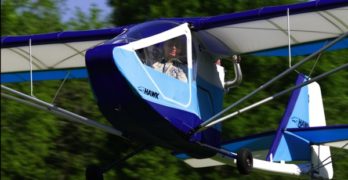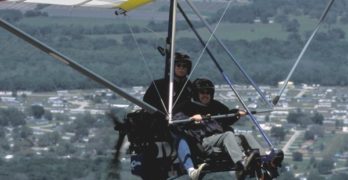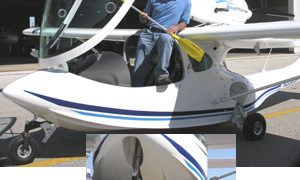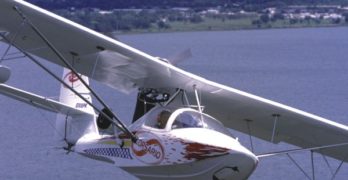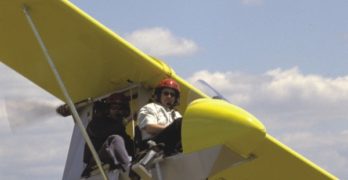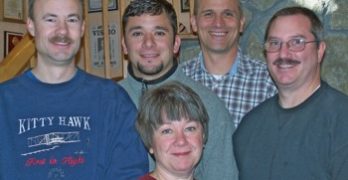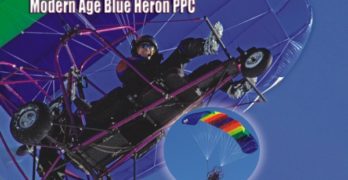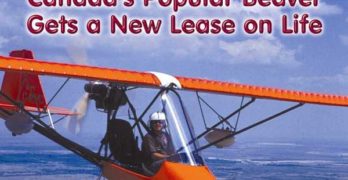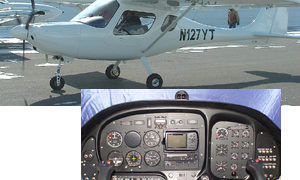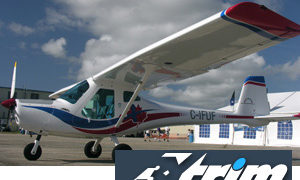… to keep the Hawk Ultra Light
Genuine ultralights still
have a place. These
aircraft|excuse me,
ultralight vehicles,
the least-FAA-regulated
flying machines,
will not be sent to aircraft boneyards
despite what some light-sport aircraft
skeptics may think. The Hawk Ultra
is proof positive CGS Aviation loves
ultralights and wants you to have fun
in the air.
No matter the pros and cons of
the sport pilot/light-sport aircraft (SP/
LSA) rule, operating a Part 103 ultralight
remains simpler than earning a
sport pilot certificate and buying an
LSA. No certificate, no medical, and
no registration is needed (though, it is
recommended that folks register with
one of the three associations supporting
ultralights-EAA, the United States
Ultralight Association (USUA), and Aero
Sports Connection (ASC). Additionally,
an ultralight can be fully factory built
without FAA inspections. The list of 103
privileges goes on, and the Hawk Ultra
qualifies for all of them.
One-Oh-Three Interest Soars
I don’t know about the “build it
and they will come” premise when
it comes to baseball fields, but I fervently
believe that if enough customers
want a product, someone will supply
it.
Search Results for : Flight Design
Not finding exactly what you expected? Try our advanced search option.
Select a manufacturer to go straight to all our content about that manufacturer.
Select an aircraft model to go straight to all our content about that model.
TC’s Trikes and North Wing Team Up on Coyote
Two years ago, I flew and reported on the only model TC’s Trikes offered. Though their line had little depth, the Tennessee company built their own wing and chassis. Many trike chassis builders purchase wings from other sources, much like happens universally in powered parachutes. TC’s Trikes did it all based particularly on their needs as an active flight school operation.
In today’s light aircraft world, a wider product line addresses more pilots, which makes a more viable business. Given the pace of refinements, it can be tough to keep up. Yet TC’s Trikes had a track record in the East, selling more than 100 trikes of their own and other brands. Pairing up with another company, if the fit was right, could be smart business.
A match was found between TC’s Trikes and Washington state-based North Wing Design. TC’s Trikes had something North Wing lacked – a presence in the Eastern USA.
Flying Boats in Florida; Sampling SeaMax
My wife, Randee, and I are finding lots of good reasons to winter in Florida (while our home state of Minnesota gets buried in snow). Here’s three of those good reasons: SeaMax, Mermaid, and Drifter on Lotus floats. Float flying in winter is different…and fun! *** I have now flown the SeaMax three times. Yesterday we did three water and three land touchdowns. What a hot little flying boat. (Earlier SeaMax SPLOG) I use the word “little” literally…the amphib high wing LSA barely comes up to my chest and gross weight is only 1,144 pounds; LSA floatplanes can weigh 1,430 pounds. At this weight SeaMax performs brilliantly with the 100-hp Rotax 912S; 4800 rpm produces more than 100 mph. SeaMax has not yet finished its work to achieve SLSA status. But since this is the designer’s 22nd creation and as over 45 SeaMax aircraft have been sold into Europe and elsewhere, the task is not difficult, just time consuming.
Boathull Corsario Arrives in America
Brazilian Amphibious Beauty
Most Americans
are unaware of the Corsario. Importer Steven Cohen is out to change that. He and his partner, Phil Klein, are marketing this handsome amphibian, which they import from Brazil. Not a brand-new design, this is the MK5 model – it’s been through four previous iterations.
The Corsario comes from a South American company called Microleve founded in 1982, back near the beginning of the ultralight era. The company proudly states, “Aside from being the first ultralight manufacturer in Brazil, the quality of our products has made Microleve the biggest seller of ultralight aircraft in Latin America.”
In 23 years of operation, Microleve claims to have delivered more than 1,400 ultralight aircraft, including almost 20 different models, named as MX1, MX2, ML200, ML300, ML300M, ML300MF, ML400, ML400T, ML450, ML500T, CORSARIO MK1, MK2, MK3, MK4, and MK5. As you might surmise by reviewing this list, the Brazilian company has taken several of their models through a series of refinements and the Corsario is no exception.
The Lil’ Breezy B-Model
Open-Cockpit 2-seater
ust when you felt as though Light-Sport Aircraft (LSA) was the only segment of aviation getting any press, along comes a flying machine that harks back to the early days of ultralighting but with a distinctive fuselage construction and composite wings.
Just when it seemed like every new LSA had to be enclosed, four-stroke-powered, fast, and have leather seats, along comes a new open-cockpit, mile-a-minute airplane that can easily carry two people on the power of a 50-hp Rotax 503. The leather is on your flight jacket.
The Lil’ Breezy B can weigh 350 pounds empty, fly at 60 mph, and sell for $12,500 (for all parts plus engine/prop but not your assembly labor). In my experience that sounds like an ultralight. Born in the new millennium, the Lil’ Breezy B is a modern ultralight.
Before we go fly, let’s examine the machine and talk to its developer, Jack Harper.
What To Do?
Some buyers are unsure how to weigh the decision between ultralight and the new light-sport aircraft. While Heldeberg Designs works on their statement of compliance to new ASTM consensus design standards, here’s some advice to Blue Heron owners from Heldeberg Designs:
“Single-seat, FAA Part 103-compliant aircraft (e.g., the Spirit 103) will have to do nothing. Part 103 will continue on in its current form.
“Older 2-seat ultralights will have to transition from the current exemption-based coverage granted by EAA, ASC, and USUA, to Light- Sport [Aircraft]. These aircraft will have to be inspected in order to receive an N-number as an Experimental Light-Sport Aircraft (ELSA). This will apply to all 2-place powered parachutes that were purchased before the new rule became effective, and provides for a 2-year transition period. This process will require owners to register their aircraft with FAA, and then have them inspected by an LSA Designated Airworthiness Representative (DAR) in order to be qualified as an ELSA aircraft.
Modern Age Blue Heron PPC
Here we are
in the spring of 2006 wondering about the future of ultralights in an age seemingly gone crazy about Sport Pilot/Light-Sport Aircraft (SP/LSA). For powered parachute manufacturer Heldeberg Designs, the answer is easy. They’ve been preparing for the LSA program for a long time. How will they fare?
Today, we have a great divide* between ultralight pilots on one side and LSA enthusiasts on the other. The ultralight pilots see rather modest benefit to becoming Sport Pilots flying ultralights converted to Experimental Light-Sport Aircraft (ELSA). One major downside is that most such aircraft will have to settle a sales tax bill (states become aware of the aircraft when owners obtain their N-numbers). Other limitations include not flying over 10,000 feet or being required to perform an annual condition inspection. And this is by no means a complete gripes list.
The LSA contingent responds, “That ship has sailed. SP/LSA is here.
Beaver RX-550
Perhaps the most famous ultralight to come out of Canada is the Beaver. With a reported 2,200 units flying since the early 1980s, this is one of the most successful light aircraft ever. However, due to missteps by companies that previously manufactured the brand, this popular ultralight was nearly lost from the ultralight aviation landscape. Were it not for the Aircraft Sales and Parts (ASAP) company and the Holomis family, you might not have this choice today.
Originally the Beaver RX-550 came from a company called Spectrum Aircraft. A company reorganization left the ultralight in the hands of a company named Beaver RX Enterprises. Both these business names disappeared and today the ASAP brand carries the Beaver into the sky.
In 1993, a couple years after our last report on the Beaver1, the old company closed its doors and effectively stranded thousands of Beaver ultralight owners and all the dealerships that sold them.
First Storm Rally Assembled in the USA
Michigan-based Prestige Aircraft recently rolled out their first U.S.-built Storm Rally. Examples of this attractive high wing aircraft seen at airshows like AirVenture 2006 were manufactured by the Italian company that created the design. Now, Prestige builds the Rally under an agreement with Storm Aircraft and plans to add the low wing Century and amphibious Sea Storm in the future. *** Rally, which won its SLSA approval in early 2006, is a carbon fiber and Kevlar reinforced composite design that comes equipped with basic flight instruments and equipment for VFR day operation including a turn-coordinator; tail-strobe; ICON 200 radio; and Garmin transponder with an altitude encoder. Unlike many other brands, national distributor Air Elite Aviation says, “All aircraft models come with a limited two-year, or 1000-hour warranty.” Rally can cruise at 107 knots (75% power) and, with 34 gallons of usable fuel, it boasts an 800 nautical mile range.
Delightful-to-Fly Light-Sport Aircraft from Poland
Much attention on LSA seems to focus on U.S.-built aircraft or those from Czech Republic. Of course we have many other countries contributing to the growing U.S. fleet including Germany, Italy, and Australia. While Poland also contributes fabrication to the German-designed FK Lightplane series, the country isn’t widely known to Americans as an LSA provider. Its fuselage boom with vertical flanges (assembled from two fuselage halves) shows how this airplane descends from sailplane gliders built for many years in Eastern Europe. Imported by Rainbow Sport Aviation in Canada, the creator of the 3X55 is Adam Kurbiel, who designed gliders at the SZD-PZL glider factory before turning his attention to light airplanes. A modest cruiser (88 knots or 101 mph at 75% power), 3X55 handles beautifully and lands easily. The 47-inch-wide interior is nicely appointed with modern controls to match more expensive aircraft. Priced at $73,500 with the 80-hp Rotax, 3X55 seems a relative bargain.
- « Previous Page
- 1
- …
- 116
- 117
- 118
- 119
- 120
- …
- 147
- Next Page »


